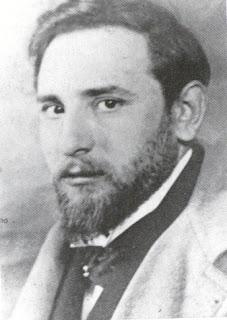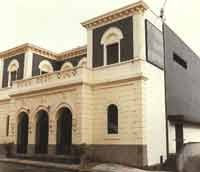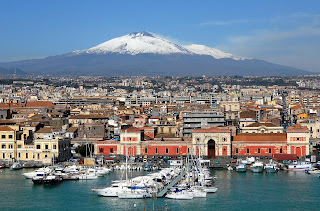NEW - Nino Martoglio - writer and film director
Journalist and playwright whose films inspired post-war neorealism
The journalist, playwright and theatre and film director Nino Martoglio was born in Belpasso, a town in the foothills of volcanic Mount Etna in eastern Sicily, on this day in 1870. Martoglio is widely considered to be Sicily’s finest dialect playwright and by some to be the founder of Sicilian theatre. He was also an acclaimed poet, basing a good deal of his verse on the everyday conversations of working class Sicilians, written to amuse. His collection, Centona, is still sold today. Later in a career that was ended abruptly by his death in an accident, Martoglio directed a number of silent films, the style of some of which prompted critics to describe them as forerunners of the post-war neorealism movement. The son of a journalist and a school teacher, Martoglio studied sailing as a young man and obtained a captain’s licence. Yet he sought a career in journalism and joined the editorial staff of La Gazzetta di Catania, a daily newspaper founded by his father, Luigi. In 1889, he launched a weekly magazine, D’Artagnan, a Sicilian language periodical devoted to art, literature and theatre, sharp political satire and the plight of the people of Civita, a poor neighbourhood in Catania. Read more…
_______________________________________
Nicolò Amati - violin maker
Grandson of Andrea Amati produced some of world's finest instruments
Nicolò Amati, who is acknowledged as the greatest in the line of Amati violin makers in the 16th and 17th centuries, was born on this day in 1596 in Cremona. The grandson of Andrea Amati, who is credited by most experts with being the inventor of the violin in its four-stringed form, Nicolò followed his father, Girolamo, and uncle, Antonio, into the family business. Girolamo and Antonio went their separate ways in around 1590, Antonio setting up a different workshop, which was thought to specialize in lutes. Initially, Nicolò made instruments that were very similar to those created by Girolamo but later began to add refinements of his own, the most significant of which came between 1630 and 1640 when he created the Grand Amati design. This model, slightly wider and longer than the violins his father had produced, yielded greater power of tone than the smaller instruments and soon became sought after. The bubonic plague outbreak that swept through Italy between 1629 and 1633 claimed the lives of both Girolamo and Nicolò's mother, Laura, and that of his main rival in violin manufacture at the time, Giovanni Paolo Maggini, from the Brescian school. Read more…
______________________________________
Nino Rota – composer
Musician and teacher composed soundtrack for The Godfather
Giovanni ‘Nino’ Rota, composer, conductor and pianist, was born on this day in 1911 in Milan. Part of a musical family, he started composing with an oratorio based on a religious subject at the age of 11, but he was to go on to produce some of the best-known and iconic music for the cinema of the 20th century. Rota studied at the Milan Conservatory and then in Rome before he was encouraged by the conductor, Arturo Toscanini, to move to America, where he studied at the Curtis Institute in Philadelphia. When he returned to Milan he took a degree in Literature and then began a teaching career. He became a director of the Liceo Musicale in Bari in 1950 and kept this post until his death. Orchestra conductor Riccardo Muti was one of his students. Rota wrote film scores from the 1940s onwards for all the noted directors of the time, including Franco Zeffirelli, Luchino Visconti and Eduardo de Filippo. He wrote the music for all Federico Fellini’s films from The White Sheik in 1952 to Orchestral Rehearsal in 1978. He composed the score for Francis Ford Coppola’s film The Godfather and won an Oscar for best original score for The Godfather Part II in 1974. Read more...
________________________________________
Carlo Oriani - cyclist and soldier
Giro winner died in World War One
The champion cyclist Carlo Oriani, winner of the 1913 Giro d’Italia, died on this day in 1917 in the aftermath of the Battle of Caporetto in the First World War. The battle was a disastrous one for the Italian forces under the command of General Luigi Cadorna, with 13,000 soldiers killed, 30,000 wounded and 250,000 captured by the victorious army of Austria-Hungary. Countless other Italian troops fled as it became clear that defeat was inevitable. Oriani, who had previously served his country in the Italo-Turkish War in 1912, was a member of the Bersaglieri, the highly mobile elite force traditionally used by the Italian army as a rapid response unit. He had joined the corps in part because of his skill on a bicycle, which had replaced horses as one of the means by which the Bersaglieri were able to get around quickly. The Battle of Caporetto took place from October 24 to November 19, near the town of Kobarid on the Austro-Italian front, in what is now Slovenia. Oriani survived the battle but it was during the retreat that Italian soldiers had to cross the Tagliamento, which links the Alps and the Adriatic and in the winter months is a fast-flowing river, with enemy forces in pursuit. Read more…
______________________________________
Matilde Malenchini – painter
The tempestuous life of a talented Tuscan artist
The painter Matilde Malenchini was born on this day in 1779 in Livorno in Tuscany. She was well-known for her paintings of church interiors but turned to portrait painting later in life to make money to help her survive after her long relationship with Belgian writer Louis de Potter ended. Matilde was born into the Meoni family and married the painter and musician Vincenzo Francesco Malenchini at the age of 16. Although they soon separated, she kept his name for the rest of her life. In 1807 she went to study at the Accademia di Belle Arte in Florence under the guidance of Pietro Benvenuti. To earn money and practise her art, she copied the works of old Italian and Dutch masters in the Uffizi Gallery in Florence. After being given a four-year annual stipend by Elisa Bonaparte, the Grand Duchess of Tuscany, in 1811, Matilde went to Rome to study at the Pontificia Accademia romana delle belle arti di San Luca, in Rome. There she met the French Governor of the Papal States, General Francois de Mollis, who was an art collector. He bought 18 of her paintings and helped her establish a studio in the convent of Trinità dei Monti. Read more…
________________________________________
Angela Luce – actress
Film star and singer was born in Spaccanapoli
Neapolitan actress and singer Angela Luce was born Angela Savino on this day in 1937 in Naples. She has worked for the theatre, cinema and television, is well-known for singing Neapolitan songs, and has written poetry and song lyrics. At 14 years old, Angela took her first steps towards stardom when she took part in the annual music festival held at Piedigrotta in the Chiaia district of Naples, singing the Neapolitan song, Zi Carmeli. Her cinema career began in 1956, when she was only 19, when she appeared in Ricordati di Napoli, directed by Pino Mercanti. Since then she has appeared in more than 80 films and has worked for directors including Luchino Visconti, Pier Paolo Pasolini, Mario Amendola, Luigi Zampa and Pupi Avati. Angela won a David Donatello award for L’amore molesto directed by Mario Martone and was also nominated for the Palma d’Oro at Cannes. She has acted opposite such illustrious names as Marcello Mastroianni, Vittorio Gassman, Alberto Sordi, Vittorio de Sica and Totò. Her voice has been recorded in the historic archives of Neapolitan songs and she has won prizes for her singing. Read more…
_______________________________________
Mario Borghezio – controversial politician
Lega Nord MEP renowned for extremist views
Mario Borghezio, one of Italy’s most controversial political figures whose extreme right-wing views have repeatedly landed him in trouble, was born on this day in 1947 in Turin. Borghezio was a member of Lega Nord, the party led by Umberto Bossi that was set up originally to campaign for Italy to be broken up so that the wealthy north of the country would sever its political and economic ties with the poorer south. He has been a Member of the European Parliament since 1999 and has served on several committees, including Civil Liberties, Justice and Home Affairs and the Committee on Petitions. He was even undersecretary to the Ministry of Justice from 1994-95. Yet he had regularly espoused extremist and racist views, to the extent that even the right-wing British party UKIP, with whom he developed strong links, moved to distance themselves from him over one racist outburst. It was at their behest that he was expelled from the European Parliament’s Europe of Freedom and Democracy group after making racist remarks about Cecile Kyenge, Italy’s first black cabinet minister, whom he said was more suited to being a housekeeper. Read more…
_______________________________________
Book of the Day: The Poetry of Nino Martoglio, introduced, edited and translated by Gaetano Cipolla
This is a selection of poems from the Centona, a well known collection of poems by Nino Martoglio, who was the founder of Sicilian dialect theater in Italy. Catania's most famous poet, Martoglio urged Luigi Pirandello to write for the theatre and co-authored two plays with him. These poems, ably translated by Gaetano Cipolla, provide a realistic view of every aspect of Sicilian life. The book is a tour de force for the poet and his translator. The Poetry of Nino Martoglio, which begins with a comprehensive biographical introduction, is a bilingual edition, in which the poems in the original Sicilian dialect appear facing Cipolla's English translation.Gaetano Cipolla was born in Sicily and emigrated to the US in 1955. After earning his PhD at New York University in 1974, he taught Italian language and literature at a number universities including NYU, Marymount, Lehman College and St. John's. He has translated numerous Sicilian poets into English and received many awards.
Booking.com
.jpg)

.jpg)













.jpg)





